Connecticut Maritime Association
-
- In Big Ship Fuel Economy, Finances Trump Regulation Maritime Reporter, May 2013 #54
While increased regulation is often cited as the primary culprit driving shipowners to adopt new energy efficient technologies and practices for their ships, one major shipowner has a differing opinion.
“You can make the argument that regulations are what’s driving it, but personally I think it’s more economics,” said Chris Errington, Director of Engineering at Maersk Line. Errington, along with industry veteran Graham Westgarth, Executive Vice President of Operations and Strategy, GasLog Logistics, was part of a panel discussion led by Dr. Kirsi Tikka, President and COO, ABS European Division, on energy efficiency of maritime vessels held on March 19, 2013 at the Connecticut Maritime Association’s Shipping 2013 event in Stamford, Connecticut.
“I think, even without the regulations, the shipyards and the economics of it are driven by the owners. The owners are the people that are demanding better designs and better efficiencies on the vessels.” Errington said, linking much of the industry’s focus on energy solutions to the “present financial climate and the economics of more energy efficient vessels.”
Given the market’s financial turbulence, squeezing fleets for the very last drop of profit has become a necessity for many shipowners. Vessel efficiency and company profits often go hand in hand, forcing shipowners to set their sights on energy solutions as an approach toward fleet-wide savings.
“[Maersk] has targets every year. Last year the target was $40 million in fuel savings, and we exceeded that. I think it was $78 million. We actually doubled it. And in the U.S. we achieved $16.7 million of that cost,” Errington said. “At the end of the day, everything is going to equate in dollar values. We’ll continue to challenge ourselves each year as we go. This year it’s a similar challenge of $80 million globally.”
But these savings are not achieved without careful consideration and attention to detail. Even seemingly small features such as marine coatings can draw big savings, Errington said. “Paint systems play a huge factor in your economies,” he noted. “We found that you can have huge savings by having the right paint system on a vessel. At Maersk in the last two years, we have taken six of our vessels out of the water, not when they were due but drydocked them early just to change the paint system. And we could see the paybacks virtually immediately.”
Echoing Errington’s view on economic-driven energy advancements, Westgarth said, “Because of the price of fuel and the pressure the industry’s under, I’m seeing more innovation than I ever have before.
“There’s different hull designs, there’s retrofits, there’s different engines, there’s a lot of focus on using LNG as a marine fuel on ships outside of the LNG business. In 10 years’ time I think we will look back and see a quantum leap.” Speaking to the economy’s impact on future design, he added, “The new generation of ships, in my view, are going to be at least 10-15% more efficient than anything that we actually see right now.”
Westgarth also referred to regulation as a driving force for proactive energy efficiency initiatives—still not without strong economic implications.
“One way or another, there will eventually be a tax on greenhouse gas emissions, whether it is a levy or a tax, there will be some form of cost associate,” Westgarth said.
“The legislation will come, and I think if you’re a responsible company it makes a lot of sense to have the systems and processes in place before the legislation so you’re not scrambling at the last minute.”
Both Maersk and GasLog along with many other companies have used ABS framework to adopt efficient best-practices for their respective fleets, but certainly not without consideration to their company’s financial interests.
Regulations provide benchmarks which help keep shipowners on track; but the economy is ultimately shining the spotlight on energy solutions and catalyzing industry efforts toward efficiency.
According to Kirsi Tikka
On the sidelines at the Connecticut Maritime Association’s Shipping 2013, in the wake of the ABS led panel discussion on energy efficiency of maritime vessels, Dr. Kirsi Tikka, President and COO, ABS European Division shared with Maritime Reporter & Engineering News.
Maersk and GasLog are strong players obviously, but was there a particular reasoning for including them in this high-level discussion?
First and foremost, they were some of the first companies to receive this certification through ABS (ISO 50001 through our HSQEEN framework, so basically they have our notation for energy management.
For many years “being green” was more marketing slogan than corporate policy. Is this changing?
I believe that almost all companies are taking some measures for fuel efficiency. Some do it in a more structured framework, such as Maersk and GasLog; others do it within their own operational framework.
In the conference, you floated the notion of self regulation for the maritime industry. Is this a reality, and what would be the driver?
Being with a class society, we are part of the industry which to a large extent is self-regulating. If you think of the class rules, it is self regulation for the industry. We have traditionally focused on structures, machinery and safety aspects … but the class role is changing clearly now we look at energy efficiency and performance. As Graham (Graham Westgarth, EVP of Operations and Strategy, GasLog Logistics) mentioned, there are a lot of political drivers, particularly in the greenhouse gas discussion.
When you look at the legislative horizon, what do you see?
Right now, clearly Ballast Water and the ECA requirements are the big ticket items. Regarding EEDI: I think industry will adapt to it, and it will not have the financial impact as the other two regulations. In the future, if there are market-based measures for greenhouse gas, it will have a huge impact on the maritime industry.
If you had to pick just one factor, in your mind what makes the operations of ships more efficient?
Well I’m not an operator, so I don’t have the same vision. But I probably would say it is the awareness and the training required to go beyond the awareness. I think with everyday actions you can gain a lot of operational efficiencies without doing anything else.
LNG as marine fuel is a common headline these days. What is the future for this fuel in the maritime sector?
There’s no question there is a future, and the biggest driver right now is the ECA regulation and the 2015 sulfur reduction mandates. It’s most attractive to companies with operations in the ECA area only, or for those that spend a lot of time in the ECA. That’s in the short term. In the long term, the driver will be the framework of LNG supply available everywhere in the world.”
Technical challenges can always be overcome, and while the technology is there there are some safety issues that need to be dealt with. If you look at LNG as a cargo, it has been a very safe industry. It’s a different matter though when you have a limited number of LNG carriers versus having an entire fleet operating on LNG as fuel. Do you have crews that know how to handle LNG. If you have more ships carrying LNG and you have an accident; there are still issues regarding the placement of the fuel tank and the type of piping to use. The fact that we don’t yet have international regulation is a concern.
What do you count as the most significant change in the role of class?
I think the biggest change is the step away from purely looking at the structure and the machinery and looking at human factors and performance aspects of the vessels. Moving into the verification of performance is a big change.(As published in the May 2013 edition of Maritime Reporter & Engineering News - www.marinelink.com)
-
- White House Promises New Merchant Marine Policy Maritime Reporter, May 1992 #4
The Deputy Secretary of Transportation, James R. Busey, told the Connecticut Maritime Association's annual conference that a Bush Administration policy designed to protect the nation's merchant marine is forthcoming. Mr. Busey said that one major reform being considered is the elimination of the
-
- Shipping 2003: Don't Stop Thinking About Tomorrow Maritime Reporter, Feb 2003 #58
Bringing together a diverse group of individuals within the maritime industry, the Connecticut Maritime Association (CMA), plans to host its annual Trade Show and Conference from March 17- 19, 2003 at the Westin Stamford Hotel in Stamford, Conn. Touting a "fragile freight market, a contentious
-
- INTERTANKO Holds Firm Position o n M a r i t i m e security Maritime Reporter, Apr 2002 #66
Speaking via a roundtable discussion at the annual Connecticut Maritime Association (CMA) Exhibition 2002 on March 19, Intertanko managing director Peter Swift summed up — in just a fewwords — the position that the organization has established since the terrorist attacks of September II. Swift has
-
- Stamford Set For Shipping 2002 Maritime Reporter, Feb 2002 #46
again serve as host to a conference and exhibition that arguably attracts the highest concentration of quality attendees of any North American show. Connecticut Maritime Association's Annual Trade Show and Conference — Shipping 2002 — is set for March 18-20, 2002. Shipping 2002 is set to break all of
-
- Managing Shipping & Risk with New Variables Maritime Logistics Professional, Q2 2014 #10
challenges for shipowners. The fuel markets have also developed tools to enable fuel buyers to manage their price risk. A March, 2014 Connecticut Maritime Association presentation by Ebony Smith, from World Fuels Corporation (WFC), a supplier to maritime and aviation modes, showed annualized volatility
-
- Profile: Coast Guard Administrative Law Judge Brudzinski Maritime Logistics Professional, Q3 2014 #40
Law Judges Conference; the National Association of Administrative Law Judiciary; the Maritime Law Association of the United States; and, the Connecticut Maritime Association. Vision for Leading the Program: Chief Judge Brudzinski’s vision for the Coast Guard ALJ Program is simple: “We are dedicated to performing
-
- One Small Step toward Sustainable Coastal Shipping Marine News, Mar 2016 #28
the Short Sea Shipping Cooperative Program under the Maritime Administration and the USDOT from 2003 until 2008. A past Vice President of the Connecticut Maritime Association, he is a contributing writer for Marine News. A graduate of the Massachusetts Maritime Academy, Kunkel sailed as a licensed engineer and
-
- US Offshore Wind Comes to Life Marine News, Oct 2016 #28
the Short Sea Shipping Cooperative Program under the Maritime Administration and the USDOT from 2003 until 2008. A past Vice President of the Connecticut Maritime Association, he is a contributing writer for MarineNews. A graduate of the Massachusetts Maritime Academy, Kunkel sailed as a licensed engineer and
-
- Emissions Regulations: 'It's Not Easy Being Green' Marine News, Mar 2018 #34
the Short Sea Shipping Cooperative Program under the Maritime Administration and the USDOT from 2003 until 2008. A past Vice President of the Connecticut Maritime Association, he is a contributing writer for Marine News. A graduate of the Massachusetts Maritime Academy, Kunkel sailed as a licensed engineer and
-
- YoungShip’s Birgit Liodden Maritime Logistics Professional, Q2 2013 #50
energy to keep up with Oslo-based Birgit Liodden. Maritime Professional magazine nevertheless caught up with her long enough at the annual Connecticut Maritime Association’s 2013 Shipping Conference to gain some insights into what makes her tick, and more importantly, why. The well-regarded young shipping
-
- The Strong and Silent Type Marine News, Jul 2017 #34
the Short Sea Shipping Cooperative Program under the Maritime Administration and the USDOT from 2003 until 2008. A past Vice President of the Connecticut Maritime Association, he is a contributing writer for Marine News. A graduate of the Massachusetts Maritime Academy, Kunkel sailed as a licensed engineer and
-
 )
March 2024 - Marine Technology Reporter page: 41
)
March 2024 - Marine Technology Reporter page: 41Image courtesy Outland Technology Image courtesy Exail Image courtesy Submaris and EvoLogics Vehicles The ROV-1500 from Outland Technology represents a leap forward in underwater robotics, a compact remotely operated vehicle (ROV) weighing in at less than 40 lbs (19kg) the ROV- 1500 is easy to transport
-
 )
March 2024 - Marine Technology Reporter page: 18
)
March 2024 - Marine Technology Reporter page: 18TECH FEATURE IMR There are also weaknesses in terms of accuracy because of FiGS Operations and Bene? ts signal noise and the ability to detect small ? eld gradients. In Conventional approaches to evaluating cathodic protection this process there is a risk that possible issues like coating (CP)
-
 )
March 2024 - Marine Technology Reporter page: 11
)
March 2024 - Marine Technology Reporter page: 11assist in identifying mines and act as a neutralization device. About the Author Bottom mines pose even greater chal- David R. Strachan is a defense analyst and founder of lenges. Unlike contact mines, bottom Strikepod Systems, a research and strategic advisory mines utilize a range of sensors to
-
 )
March 2024 - Marine Technology Reporter page: 8
)
March 2024 - Marine Technology Reporter page: 8INSIGHTS SUBSEA DEFENSE Copyright RomanenkoAlexey/AdobeStock WHEN THE SHOOTING STOPS: BLACK SEA MINE CLEARANCE WILL FEATURE ADVANCED TECH, CONOPS By David Strachan, Senior Analyst, Strikepod Systems ince the beginning of the war in Ukraine, mine warfare mines have been the weapon of choice for both
-
 )
March 2024 - Marine Technology Reporter page: 6
)
March 2024 - Marine Technology Reporter page: 6MTR Editorial Advisors Gallaudet Hardy The Honorable Tim Gallaudet, Kevin Hardy is President PhD, Rear Admiral, U.S. of Global Ocean Design, Navy (ret) is the CEO of creating components and Ocean STL Consulting and subsystems for unmanned host of The American Blue vehicles, following a career
-
 )
March 2024 - Marine Technology Reporter page: 4
)
March 2024 - Marine Technology Reporter page: 4Editorial NIWA-Nippon Foundation TESMaP/ Rebekah Parsons-King www.marinetechnologynews.com ast month marked the resounding NEW YORK 118 E. 25th St., New York, NY 10010 return of Oceanology Interna- Tel: (212) 477-6700; Fax: (212) 254-6271 tional in London, perennially one Lof the world’s most important
-
 )
April 2024 - Maritime Reporter and Engineering News page: 48
)
April 2024 - Maritime Reporter and Engineering News page: 48Index page MR Apr2024:MN INDEX PAGE 4/5/2024 1:33 PM Page 1 ANCHORS & CHAINS MILITARY SONAR SYSTEMS tel:+44 (0) 1752 723330, [email protected] , www.siliconsensing.com Anchor Marine & Supply, INC., 6545 Lindbergh Houston, Massa Products Corporation, 280 Lincoln Street, SONAR TRANSDUCERS
-
 )
April 2024 - Maritime Reporter and Engineering News page: 43
)
April 2024 - Maritime Reporter and Engineering News page: 43“The industry is an ecosystem which includes owners, managers, mariners, shipyards, equipment makers, designers, research institutes and class societies: all of them are crucial,” – Eero Lehtovaara, Head of Regulatory & Public Affairs, ABB Marine & Ports All images courtesy ABB Marine and Ports provi
-
 )
April 2024 - Maritime Reporter and Engineering News page: 42
)
April 2024 - Maritime Reporter and Engineering News page: 42OPINION: The Final Word Seeing the Ship as a System Shipping must engage with the decarbonization realities that lie ahead by changing the way it crafts maritime legislation to re? ect its place in the interconnected, interdependent world economy, said Eero Lehtovaara, ABB Marine & Ports. ABB Marine &
-
 )
April 2024 - Maritime Reporter and Engineering News page: 41
)
April 2024 - Maritime Reporter and Engineering News page: 41Nautel provides innovative, industry-leading solutions speci? cally designed for use in harsh maritime environments: • GMDSS/NAVTEX/NAVDAT coastal surveillance and transmission systems • Offshore NDB non-directional radio beacon systems for oil platform, support vessel & wind farm applications
-
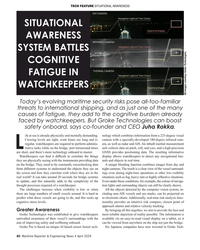 )
April 2024 - Maritime Reporter and Engineering News page: 40
)
April 2024 - Maritime Reporter and Engineering News page: 40TECH FEATURE SITUATIONAL AWARENESS SITUATIONAL AWARENESS SYSTEM BATTLES COGNITIVE FATIGUE IN WATCHKEEPERS All images courtesy Groke Technologies Today’s evolving maritime security risks pose all-too-familiar threats to international shipping, and as just one of the many causes of fatigue, they add
-
 )
April 2024 - Maritime Reporter and Engineering News page: 39
)
April 2024 - Maritime Reporter and Engineering News page: 39Tech Files Latest Products, Systems and Ship Designs “Wall Climbing Robot” Danish Pilot calls gets ClassNK Nod LEGO Model "A tribute build to a work life at sea" Image courtesy MOL, Sumitomo Heavy Industries lassNK granted its Innovation Endorse- Image courtesy Espen Andersen/DanPilot ment for
-
 )
April 2024 - Maritime Reporter and Engineering News page: 38
)
April 2024 - Maritime Reporter and Engineering News page: 38Tech Files Latest Products, Systems and Ship Designs Zero-Emission Mooring Service of a Tanker Consulmar achieved a milestone by executing what it calls ing boat Castalia, which operates on full electric propulsion. the world's ? rst zero-emissions mooring service for a tanker. Equipped with two 150 kW
-
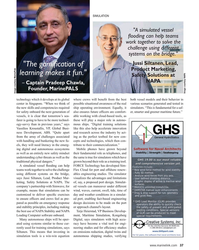 )
April 2024 - Maritime Reporter and Engineering News page: 37
)
April 2024 - Maritime Reporter and Engineering News page: 37SIMULATION "A simulated vessel ? ooding can help teams work together to solve the challenge using different systems on the bridge." – Jussi Siltanen, Lead, "The gami? cation of Product Marketing, learning makes it fun." Safety Solutions at NAPA – Captain Pradeep Chawla, Founder, MarinePALS Image
-
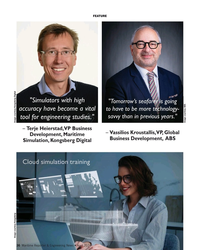 )
April 2024 - Maritime Reporter and Engineering News page: 36
)
April 2024 - Maritime Reporter and Engineering News page: 36FEATURE "Simulators with high "Tomorrow’s seafarer is going accuracy have become a vital to have to be more technology- savvy than in previous years." tool for engineering studies." Image courtesy ABS – Terje Heierstad, VP Business – Vassilios Kroustallis, VP, Global Development, Maritime Business
-
 )
April 2024 - Maritime Reporter and Engineering News page: 35
)
April 2024 - Maritime Reporter and Engineering News page: 35SIMULATION e have a close relationship with tech- Realism is prized beyond immersive, photo-realistic visu- nology, evidenced by, for example, als, and providers are introducing increasingly accurate func- the phones we are estimated to un- tionality. FORCE Technology’s upcoming DEN-Mark2 math- lock around
-
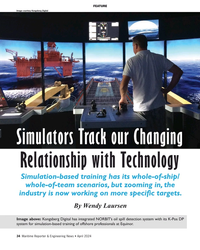 )
April 2024 - Maritime Reporter and Engineering News page: 34
)
April 2024 - Maritime Reporter and Engineering News page: 34FEATURE Image courtesy Kongsberg Digital Simulators Track our Changing Relationship with Technology Simulation-based training has its whole-of-ship/ whole-of-team scenarios, but zooming in, the industry is now working on more speci? c targets. By Wendy Laursen Image above: Kongsberg Digital has integrated
-
 )
April 2024 - Maritime Reporter and Engineering News page: 32
)
April 2024 - Maritime Reporter and Engineering News page: 32FEATURE A closeup of a blade installation process taken via drone. A blade handling system is apparent (in yellow). Images courtesy of Mammoet requirement for the development of these cranes, particularly ling area. This would result in a major time and fuel saving. in ? oating offshore wind,” says
-
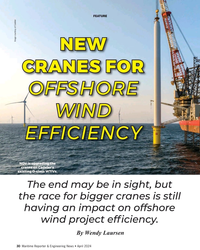 )
April 2024 - Maritime Reporter and Engineering News page: 30
)
April 2024 - Maritime Reporter and Engineering News page: 30FEATURE Image courtesy of Cadeler NEW CRANES FOR OFFSHORE WIND EFFICIENCY NOV is upgrading the cranes on Cadeler’s existing O-class WTIVs. The end may be in sight, but the race for bigger cranes is still having an impact on offshore wind project ef? ciency. By Wendy Laursen 30 Maritime Reporter
-
 )
April 2024 - Maritime Reporter and Engineering News page: 28
)
April 2024 - Maritime Reporter and Engineering News page: 28FEATURE INTERVIEW track missiles and warheads for the Mis- sile Defense Agency, and it travels with its support ship, the MV Hercules. For our Service Support ships, we have the two hospital ships, USNS Mer- cy and Comfort; two rescue and salvage ships; two submarine tenders; and the Sixth Fleet ?
-
 )
April 2024 - Maritime Reporter and Engineering News page: 27
)
April 2024 - Maritime Reporter and Engineering News page: 27RADM PHILIP SOBECK, MILITARY SEALIFT COMMAND With COVID, we had to make some hard choices for our Do your CIVMARs have upward mobility? mariners because we couldn’t rotate. Many of our mariners The Navy has Sailors who become “Mustangs,” and work found other employment, and were able to use their skills
-
 )
April 2024 - Maritime Reporter and Engineering News page: 26
)
April 2024 - Maritime Reporter and Engineering News page: 26FEATURE INTERVIEW “Over the next decade, 12 new classes of ships will come online and MSC will see up to 20 new ships deliver to the ? eet in the next ? ve years. This includes new oilers, towing, salvage and rescue tugs, and expeditionary fast transports and emergency medical ships. A large
-
 )
April 2024 - Maritime Reporter and Engineering News page: 25
)
April 2024 - Maritime Reporter and Engineering News page: 25RADM PHILIP SOBECK, MILITARY SEALIFT COMMAND Photo by Brian Suriani USN Military Sealift Command From a global supply chain perspective, What makes MSC so vital to the we’ve learned a lot about dealing with Navy’s ? eet and our military disruptions. COVID delivered a big forces around the world? wake-up
-
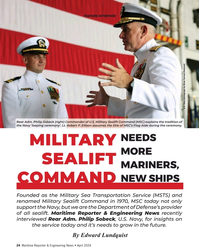 )
April 2024 - Maritime Reporter and Engineering News page: 24
)
April 2024 - Maritime Reporter and Engineering News page: 24FEATURE INTERVIEW U.S. Navy photograph by Brian Suriani/Released Rear Adm. Philip Sobeck (right) Commander of U.S. Military Sealift Command (MSC) explains the tradition of the Navy ‘looping ceremony’. Lt. Robert P. Ellison assumes the title of MSC’s Flag Aide during the ceremony. NEEDS MILITARY MORE
